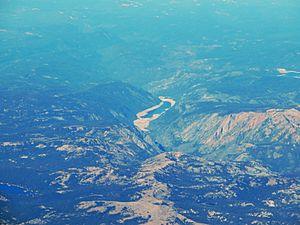Salt Springs Reservoir facts for kids
Quick facts for kids Salt Springs Reservoir |
|
|---|---|

Aerial view
|
|
| Location | Amador / Calaveras counties, California, United States |
| Coordinates | 38°29′55″N 120°12′54″W / 38.49861°N 120.21500°W |
| Type | reservoir |
| Basin countries | United States |
| Surface elevation | 3,900 ft (1,200 m) |
| Settlements | Tamarack |
Salt Springs Reservoir is a large, human-made lake located in the eastern parts of Amador County and Calaveras County in California. It sits high up in the Sierra Nevada mountains, about 30 miles (48 km) east-northeast of the town of Jackson. This reservoir is found within the beautiful Eldorado National Forest at an elevation of about 3,900 feet (1,189 meters) above sea level.
Contents
What is Salt Springs Reservoir?
Salt Springs Reservoir is a special type of lake called a reservoir. It was created by building a dam across a river. This particular reservoir holds about 141,900 acre-feet (175 million cubic meters) of water. That's a lot of water!
How Was the Reservoir Formed?
The reservoir was formed by building the Salt Springs Dam on the North Fork of the Mokelumne River. The dam is made of rock with a concrete face. It stands 332 feet (101 meters) tall. Construction of the dam was finished in 1931.
Who Owns Salt Springs Reservoir?
The reservoir and dam are owned by Pacific Gas and Electric (PG&E). PG&E is a big company that provides electricity. The main reason this reservoir was built was to produce hydroelectricity. Hydroelectricity is power made from moving water.
How Does it Make Electricity?
Water from the reservoir flows through a short pipeline to the Salt Springs Powerhouse. This powerhouse has machines that use the moving water to create 44 megawatts of electricity. After making power, some of the water goes back into the river. However, much of it flows into a special concrete channel called the Tiger Creek Conduit. This channel carries water to other powerhouses downstream, helping to make even more electricity for PG&E.
What Challenges Has the Dam Faced?
Over the years, the Salt Springs Dam has had some issues. When it was first built, the rocks inside the dam didn't settle together very well. This caused the dam to shift a bit, which led to cracks in its concrete face. These cracks sometimes caused water to leak.
How Were the Leaks Fixed?
To fix the leaks, engineers decided to cover parts of the dam with a flexible material called a geomembrane. Think of it like a giant, strong waterproof sheet. This special cover was installed in 2005 to stop the water from leaking out.
What Are Future Plans for the Dam?
Engineers are currently looking at Salt Springs Dam for a new project. They are thinking about using it as the lower part of a "pumped-storage" power system. This system would work with another dam, the Bear River Dam, as the upper part.
What is Pumped-Storage Hydroelectricity?
Pumped-storage hydroelectricity is a way to store energy. During times when there's extra electricity, water would be pumped from Salt Springs Reservoir (the lower pool) up to Bear River Dam (the upper pool). Then, when electricity is needed, the water would be released from the upper dam, flowing back down through turbines to generate power. This helps to make sure there's always enough electricity when people need it.
Images for kids




